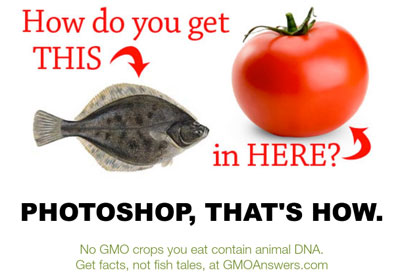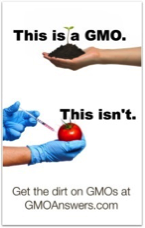The Most Common GMO Myths
GMO Answers encourages you to Get to Know GMOs—ask your toughest questions and join the conversation online. You’ll find a lot of misinformation and false claims about GMOs—that they cause cancer or aren’t tested for safety, among others – on the Internet. Here, we’ll correct five common misconceptions about GMOs.
Misconception #1: If it’s extra-large, seedless, looks weird, tastes bad, and feels squishy – it must be a GMO.
There’s a lot of confusion out there about what is a GMO and what isn’t. Just because a  strawberry is extra-large and shaped kind of funny, that doesn’t mean it’s a GMO.
strawberry is extra-large and shaped kind of funny, that doesn’t mean it’s a GMO.
When people refer to genetically modified organisms (GMOs), they are referring to crops developed with genetic engineering. Okay, then what’s genetic engineering? It is a breeding technique which enables plant breeders to take individual traits from one plant or organism and transfer them to the plant that they want to improve. It can also be used to make a change to an existing trait in a plant. For more on this, check out this post on what a GMO is and isn’t.
It is important to note that there are nine GM crops sold commercially in the United States, with the GM apple approved and coming to market soon:
Looking for more information? Check out the GMO Answers Pinterest board, and learn more about what foods are GMOs here.
Misconception #2: GMOs aren’t safe and they’re only tested by the companies making them.
You may have heard the rumors that GMOs cause cancer, autism, allergies, gluten intolerance, or other illnesses and conditions in humans and animals. While this makes for catchy headlines, it is simply not true.
GMOs are the most regulated and tested product in agricultural history. Click here to find hundreds of independent studies, which you can also search for on Biofortified.org. Additionally, many independent scientists and organizations around the world – such as the U.S. National Academy of Sciences, United Nations Food and Agriculture Organization, World Health Organization, American Medical Association and the American Association for Advancement of Science – have looked at thousands of scientific studies and concluded that GM food crops do not pose more risks to people, animals or the environment than any other foods.
Before they reach the market, crops from GM seeds are studied extensively to make sure they are safe for people, animals and the environment. GMOs take years, and millions of dollars, to come to market. Click here to find out how much time, money and research goes into every GMO you eat before you ever see it.
Did you know, that some GM plants, like Golden Rice, Vitamin A and iron-enriched bananas, and nutritionally improved cassava, can actually benefit human health. In fact, GM crops might be able to prevent or reduce allergies in the future. For example, a GM peanut could help to alleviate peanut allergies.
For more information, check out these presentations from Dr. Karl Haro von Mogel from the University of Wisconsin, Madison on potential future GM crops, and Dr. Bruce Chassy from the University of Illinois at Urbana Champaign on the risks, benefits and safety of GM crops.
Misconception #3: There is animal DNA in GMOs.
Once upon a time there was an experimental tomato that contained a gene from the winter flounder to increase the tomato's resistance to frost, but that tomato was never commercialized. While that tomato did not survive, its legend continues to live on in online search engines. While there are many fake images online featuring fishy tomatoes, there are, in fact, no GMO tomatoes commercially available today. Further, there are no commercial GM crops on the market today that are genetically modified to contain “animal genes”.
 It’s important to note that an estimated 60 percent of the genes in plants have very similar copies in animals. While DNA isn’t specifically pulled from a fish and combined with a plant, DNA from any source is made up of the same four basic nucleotide building blocks: adenine (A), cytosine (C), thymine (T), and guanine (G). DNA that comes from a plant or a microbe has the same four nucleotides as the DNA in animals.
It’s important to note that an estimated 60 percent of the genes in plants have very similar copies in animals. While DNA isn’t specifically pulled from a fish and combined with a plant, DNA from any source is made up of the same four basic nucleotide building blocks: adenine (A), cytosine (C), thymine (T), and guanine (G). DNA that comes from a plant or a microbe has the same four nucleotides as the DNA in animals.
Get more information on this misconception, including links to articles on the subject, here.
Misconception #4: GMOs have pesticides injected into them.
Some GMO crops are genetically engineered to fight off pests…but if you search online, you will  usually be led to believe that this happens by using a syringe to inject pesticides directly into a plant, most commonly the syringe injecting a tomato. (There are no genetically engineered tomatoes.) However, some crops, like corn and cotton, have been genetically engineered to resist pests, reducing damage to these crops and the need for as many pesticide applications. These seeds contain a protein from Bacillus thuringiensis (Bt), a common soil bacterium, allowing them to resist very specific pests. The Bt protein is only toxic to certain types of insects that feed on the plants, like the European Corn Borer. Bt is not toxic to humans, other mammals or other insects. In fact, Bt has been used for more than 100 years in organic farming as a pesticide spray.
usually be led to believe that this happens by using a syringe to inject pesticides directly into a plant, most commonly the syringe injecting a tomato. (There are no genetically engineered tomatoes.) However, some crops, like corn and cotton, have been genetically engineered to resist pests, reducing damage to these crops and the need for as many pesticide applications. These seeds contain a protein from Bacillus thuringiensis (Bt), a common soil bacterium, allowing them to resist very specific pests. The Bt protein is only toxic to certain types of insects that feed on the plants, like the European Corn Borer. Bt is not toxic to humans, other mammals or other insects. In fact, Bt has been used for more than 100 years in organic farming as a pesticide spray.
Learn more about how Bt crops work in this post by Andrew Kniss, Associate Professor of Weed Ecology & Management, Department of Plant Sciences at the University of Wyoming on GMO Answers, and this post by University of California, Berkeley biologist Michael Eisen. Get more information on naturally occurring pesticides here.
Misconception #5: GMO companies force farmers to grow their crops, or sue farmers if GMO seeds or pollen blow into their fields.
Farmers choose what seeds to grow based on what is best for their farms, market demand, and local growing environments. In fact, there are a wide variety of seed options available to farmers, including organic, hybrid, conventional, and GM. Many farmers successfully grow organic, non-GM and GM crops on the same farm. Jillian Etress, a high school agriculture teacher and family farmer from South Alabama, explains in this post that, on her farm, they “choose to use or not use GMOs based on the needs of our farm.” In this post, Indiana farmer Brian Scott talks about his experience purchasing seeds for his farm and explains that "none of the seed companies force farmers like me to buy any particular product…I can buy any seed from any vendor I choose from one year to the next."
With regard to biotech companies suing farmers for GMO seeds or pollen blowing into their fields, this is simply not true. In this post, Greg Conko, Senior Fellow at the Competitive Enterprise Institute, explains that “Urban legends also claim that biotech seed companies troll the country, suing farmers for patent infringement when their crops have been accidentally cross pollinated by a neighbor’s genetically engineered plants. But not a single known case of this has actually occurred. The myth is spread by misrepresenting cases, such as that of Canadian farmer Percy Schmeiser, who claimed he was sued when patented Roundup Ready canola plants were discovered on his farm. But the Canadian court that heard his case concluded that Schmeiser had intentionally planted canola seeds containing the patented Roundup Ready gene and was not merely a victim of unintended cross pollination.”
Looking for more information?
- Check out the GMO Answers Fact or Fiction board, where we're curating content from across the Internet that will help you debunk common myths, as well as resources to help you sort scientific fact from fiction.
- Popular science debunks 10 common claims in this post.
- NPRs The Salt also “busts” their top 5 GMO seed myths in this post.
- Reason corrects the “top five lies about biotech crops.”
If you have additional questions, feel free to search our archives. Stay tuned for more information to help you get to know GMOs !
